Note
I am interested in the Sicilian and Italian traditions! Can you direct me as to where to learn more about this/explain the basics of this practice? Thank you so much- your blog is great:)
Italian Witchcraft and FolkloreHey! That’s wonderful! They’re surprisingly difficult to find any accurate information on! My best resources are the article by Sabina Magliocco titled Witchcraft, healing, and vernacular magic in Italy, a less reliable article (that mixes witch-lore and folk magic all together) by J.B. Andrews called Neapolitan Witchcraft, and Carlo Ginzburg’s book The Night Battles about the benandanti in Friuli (Northeastern region of Italy).
If anyone knows any other sources feel free to list them!
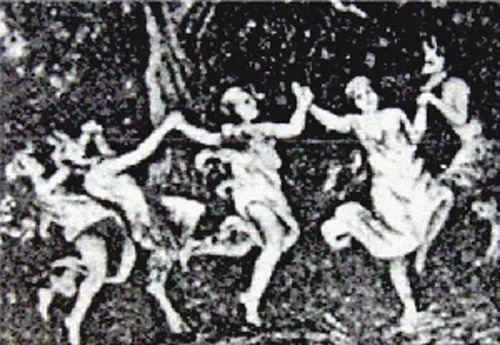

Italian witch lore is very old, as there have been legends of witches in this region for a very long, accountable period. The word strega (witch) most likely comes from the Latin strix (screech owl) which witches were thought to take the shape of in the night. The practice of witchcraft is called stregoneria, a male witch is a stregone, and a female witch is a strega. There are more legends of Italian witches in the south (particularly near Naples). One of the most famous is the story of the witches of Benevento, who convened beneath a walnut tree on a hill therein, and danced and worshiped the Devil. This tree was supposedly cut down.

There is a popular image of a witch who arises among Christian tradition in Italy, even still today. This witch is called Old Befana or Bella Befana(Bruta Befana, Bella Befana or Vecchia Befana) who is a good witch who lived alone in a small cottage. One day, three wise men knocked on her door. “Behold! The child of God is born, (yada yada) we’re going to find him and bring him gifts! Will you join us Old Befana?” Now, Old Befana was glad to hear the news and excited to meet the new babe and give it what gifts she could. However, she was not one to shuck her responsibilities so she said she would have to wait until her chores were completed. They agreed and she saw them off, before finishing her cleaning. Once her duties were completed, she packed up her presents for the babe, hopped promptly onto the broom she had just finished sweeping with, and flew out the chimney into the cold night. However, they had not told her how to find them again! Not wanting to deny the boy his gifts, she decided to give some to all the little children she passed on her way, as any might be the new born child of God. Every year on that same night, Old Befana rides out on her broom and deposits gifts for little children, in hopes that one day she will finally find the baby Jesus and give him the presents she has been holding all this time.In southern Italy, many of the tales of witches (streghe) and folk healers (fattucchiere, or ‘fixers’) tell of the songs they sing to work their magic. Unfortunately, this seems to be all anyone knows on the subject, and I can’t find any references or information on these songs! In lore, the witches of both benevolent and malefic natures are closely related or interchangeable with more faerie-like spirits. The Janare of Naples/Janas of Sardinia (lit. followers of Diana) are magical women said to live in Neolithic shaft tombs and are expert weavers and spinners. They sometimes intermarry with humans, but are very different from the cogas (or little cooks) of Sardinia, who are malefic witches that cook and eat their victims.
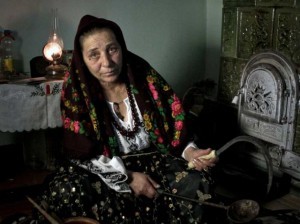
Most folk magic in Italy has died out, even in many of the rural areas. What is documented and what remains is all, unsurprisingly, Catholic magic. Much of it draws to saints, prayers, and Catholic holy tools. One name for this form of magic is benedicaria. However, much of it seems more agricultural or magical and less religious in nature. There is no point assuming this other source is pagan, because we could never prove where almost of any of it originated. Most witchcraft you will find today in Italy, especially in urbanized areas, is of a New Age or Neo-pagan persuasion. Neo-Wicca is about the best you can hope to find, and even that is comparatively rare to that found in Great Britain, Australia, and the U.S.In conversations about Italian magic and witchcraft, Raven Grimassi’s book Italian Witchcraft tends to come up. THIS BOOK IS UTTER BULLSHIT. HOGWASH. STUFF AND NONSENSE. It’s almost literally just Neo-Wicca with different names and some made up information. I’m not exaggerating. If you have this book, it’s better off as kindling than on your bookshelf. Just saying. Charles Leland’s book Aradia: The Gospel of the Witches is a pretty piece of poetry, and perhaps has some truths in it, but it can never be relied upon. His source is not credible, and the information doesn’t add up well. It is a beautiful book, but not an accurate account of Italian magic or witchcraft. Here are a few blog posts I have made relating to Italian witchcraft and folk magic:
The Curse of the Lemon and Pins
Neapolitan Flying Ointment
The Use of Stones in Italian Folk Magic
Charm Against the Evil Eye
To Cure Jaundice
To Cure Worms
To Bind an Eagle from your Flock
To Keep Birds from the Crops

1K notes
·
View notes
Text
Andrzejki - feast of love divinations in Poland

This is a feast celebrated on the night of 29th/30th November. It’s believed to be a magical night suitable for the love spells, and was celebrated throughout the centuries mostly by the unmarried people who wanted to reveal their future husband or wife. Similar feasts are also observed for example in some parts of Ukraine, Slovakia, Russia, Germany, Austria and Romania [read more here].
A BIT OF HISTORY
The original name of these celebrations was lost in history. The oldest historical sources confirm that this kind of custom was an old tradition in Poland already around 14th-15th centuries. Informations about Polish women who were sentenced to death for conducting wax divinations (described below) can be found in 16th-century documents.
Nowadays the Poles celebrate primarily the Andrzejki (St.Andrew’s Eve), but some remnants of a similar feast of Katarzynki also survived - it was celebrated on the Eve of St. Catherine / Katarzyna (24th/25th Nov), and survived the longest in the region of Biskupin.
It is said that Andrzejki was dedicated primarily to the girls who wanted to know more about their future partner, and Katarzynki was the best for the boys to make divinations.
THE DIVINATIONS
The most popular form of divinations in Poland is pouring hot wax onto cold water. The wax is first melted over fire in a small mug, then poured through a keyhole. People wait until it hardens properly in the cold water, then the pieces of wax are held against a candle to produce shadow on a wall. Its shapes symbolize things that will happen in the upcoming year.
Instead of a key, in the old days people were using for example woven straw or a horseshoe. In case of lack of a proper key, it’s also acceptable to cut a shape of it out of e.g. cardboard. In the past many people were also using melted lead instead of wax.

Wax divinations prepared by Urzecze Ensemble.

Pouring the wax.

The piece of wax can be rotated in all directions until its shadow creates a distinctive shape.
Other popular divinations include a race of shoes. Everyone gathered in the room take off one of their shoes and place in a line on the floor. The last shoe in the line is carried to the front - the process is repeated until one of the shoes reaches the front door and crosses the theshold.
Originally it symbolized a girl leaving her home, and owner of the lucky shoe will be the first from the group to get married in the future.

Preparing the shoes for divinations (Urzecze Ensemble).

The shoe race can be sometimes manipulated by tilting of the line.
Some old divinations involve also the house pets. Each person prepares a small bowl with treats - for example milk for a cat or pieces of meat for a dog - and then places it on the floor. Owner of the bowl from which the pet eats first will be the first to get married (or find their true love).
In the old days the treats were prepared very carefully - they were for example small cakes made of certain ingredients, mixed with water that was gathered in a certain way from a well or a brook (brough home for example only in a red mug or only in your own mouth), and baked over fire that was ignited with a wood plank borrowed (or stolen) from a neighbour.
If the pet runs away out of the room with the treat, it was also a good sign meaning a marriage (symbolic crossing of the treshold). However, if the animal hides under a bed with the treat, it meant death of the food’s owner. If the food is only bitten and left in the bowl or close to it, it meant that the partner would break up.

Treats prepared for a dog. Drawing by Robert Sawa.
Other popular divination require preparing of pieces of paper with names of the crushes written on it. In one of the versions the paper (preferably in a shape of a heart) is then turned around and pierced with a pin to reveal which of the names is the future spouse. The paper can be also pinned to a wall and serve as a dartboard.
In another version, much older, the people prepare small strips of paper, in a form of lots, and put them under the pillow - they draw one in the morning right after waking up.
Regardless of the version, the papers should always have at least one empty spot / one empty lot in case neither of the chosen names is the destined one.
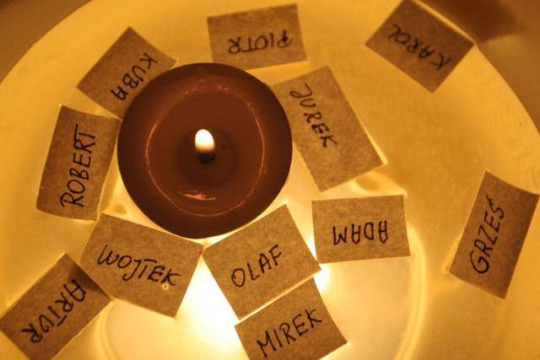
Before another popular game of divinations the people prepare mugs, flipped upside-down, and hide a symbolic accessory under each of them. The mugs are shifted around, and a person (with their eyes covered) chooses one. The hidden accessory indcates the future. It could be for example a ring or a female cap meaning marriage; a twig of rue or a dry leaf meaning spinsterhood / bachelorhood; a rosary, its beads, or a cross meaning a religious life or even life in a monastery; a coin meaning a wealthy life (but not necessarily full of love); a doll meaning an illegitimate child. One mug should be always empty - it means that nothing will change in the nearest future.
The divinations have dozens of regional types in Poland, and often take forms of various games or competitions. Many customs are sadly forgotten or not practiced anymore, only being told in stories by the oldest generations.
In the modern days the people treat Andrzejki as a special night that strenghtens and ensures effectiveness of various divinations - many of modern activities come also in forms that are known worldwide, for example reading cards or tea leaves. Among most of the modern Polish society the divinations are no longer taken seriously, and are only an occasion for a unique once-in-a-year party, very often combined with celebrations of Andrzej’s namesday.
Sources of pictures: Leksykon Lublin, Łowiczanin.info, Czas Bocheński, Gazeta Wrocławska, Dziennik, Garnek.
748 notes
·
View notes
Text
☥ Ancient Egyptian Festival Calendar

0 notes
Text
Learning Cartomancy: The Numbers | Article Series
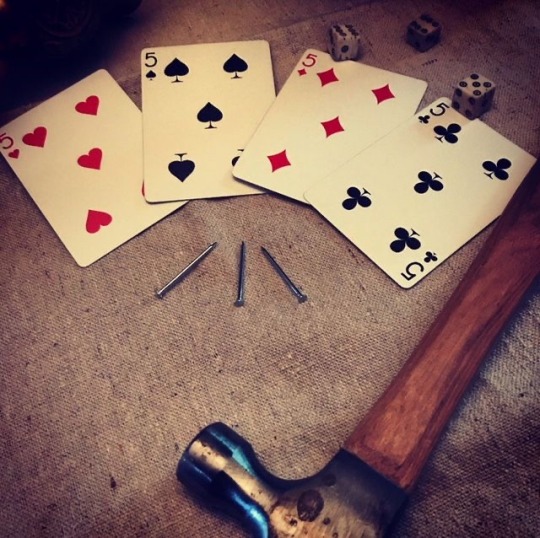
Below is a collection of articles from the blog Necromantic Matters, outlining the correspondences for each of the card numbers as they pertain to playing card divination:
Aces // Twos // Threes // Fours // Fives // Sixes // Sevens // Eights // Nines // Tens
Image source: the author’s website
19 notes
·
View notes
Text
Herbal Tea Remedies
From KitchenWiccan.com
21st Century Tea
There are so many ways that our immune systems can be overwhelmed … it’s in our air, our water, our food, our workplace, our stress. This blend of organic and wild herbs is not only helpful but comforting, strengthening and tasty.
1 part red clover blossoms
1 part nettle leaves
1 part pau d’Arco
1 part alfalfa & sage leaves
1 part St.Johns wort tops
1 part ginger root
Place all herbs in a tea ball or bag, put in your nicest or most favorite cup or mug, and cover with boiling water. Steep for 10 minutes.Remove tea ball or bag, and add sugar, honey, sweetener, milk, cream or whatever, to taste.
ADD/ADHD Remetea
1Teaspoon Hops
1 Teaspoon Gotu Kola
Bring 1 ½ cups of water to a boil. Place the herbs inside, place lid on tightly and let it steep for 5 minutes. Drink twice a day.
After Dinner Carminative Tea
1 cup water
1 tablespoon fennel seeds
Bring the water and fennel seeds to a boil with the lid on the pan and let sit for 15 minutes and enjoy this calming cup of tea. Fennel is a wonderful herb for digestion and can help your body increase its ability to digest a big meal or a meal with lots of fat.
Allergy Season Blend
Cool minty, citrus flavour to assist you with the discomfort associated with allergy season.
1 part nettle
1 part peppermint
1 part spearmint
1 part yerba santa
1 part eyebright
1 pat lemongrass leaves
1 part calendula
1 part red clover
1 part lavender flowers
1 part fennel seeds
a pinch of stevia
Place all herbs in a tea ball or bag, put in your nicest or most favorite cup or mug, and cover with boiling water. Steep for 10 minutes. Remove tea ball or bag, and add sugar, honey, sweetener, milk, cream or whatever, to taste.
Aphrodite Blend Tea
A sensuous, aromatic blend with just the right tint of zest for your palate, and sure to kindle flames! A delicate, but dashing combination makes this one of your most enjoyable cups of tea.
1 part Damiana leaves
1 part rose petals
1 part peppermint leaves
1 part muira puama
1 part gingko leaves
1 part orange peel
1 part cinnamon bark chips
pinch of stevia.
Place all herbs in a tea ball or bag, put in your nicest or most favorite cup or mug, and cover with boiling water. Steep for 10 minutes.
Remove tea ball or bag, and add sugar, honey, sweetener, milk, cream or whatever, to taste.
Bladder Infections Tea
1 ½ oz dried Goldenrod
¼ oz Juniper Berries*
¾ oz chopped Dandelion root
¾ oz chopped Rose Hips
Pour 1 cup boiling water over 2 tsp of mixture. Steep 10 minutes & strain.
*can become toxic, so only drink 2 cups of this mixture daily for no more than 3 days*
Blood Builder Tea
1 tsp Rose Hips-crushed
1 Tsp Butcher’s Broom
1 Tsp Yellow Dock
Bring 31/2 cups of water to a boil. Remove water from heat and add herbs. Place a tight lid on the pot. Let the mixture steep for five to ten minutes. Drink one cup three times daily. Yields three cups.
Blossoms of Health Tea
Beautiful to look at, nectar to taste and good for you. A popular tea. Spirited, uplifting and energizing.
1 part ginkgo leaves
1 part red clover tops
1 part nettle leaves
1 part meadowsweet leaves
1 part calendula
2 parts chamomile
2 parts lavender flowers
1 part gotu kola leaves
a pinch of stevia.
Place all herbs in a tea ball or bag, put in your nicest or most favorite cup or mug, and cover with boiling water. Steep for 10 minutes.
Remove tea ball or bag, and add sugar, honey, sweetener, milk, cream or whatever, to taste.
Blues Tea
1 part Nettle leaves,
1 part St Johns wort tops
2 parts spearmint
1 part damiana leaves
1 part kava kava root
a tiny pinch of stevia to taste
Place all herbs in a tea ball or bag, put in your nicest or most favorite cup or mug, and cover with boiling water. Steep for 10 minutes. Remove tea ball or bag, and add sugar, honey, sweetener, milk, cream or whatever, to taste.
Breast Health Tea
2 parts calendula
2 parts red clover
1 part cleavers
1 part lady’s mantle
Spearmint or peppermint (optional; for flavor)
Prepare as an infusion, using 1 ounce of herbs per quart of water, and letting steep overnight. Drink 3 to 4 cups daily.
Bronchial Congestion Tea
1 ½ oz Aniseed
1 oz Calendula flowers
¾ oz Marshmallow root
1/3 oz Licorice root
Crush anise seeds and add to herbs. Pour 1 cup boiling water over 1 tsp mixture; cover & steep 10 minutes.
Calming Tea 1
1 oz Lemon balm
1 oz Chamomile flowers
½ oz St Johns Wort
Steep 2 tbs of mixture in 1 cup boiled water. Cover 10 minutes; strain.
Calming Tea 2
1 Part Sage
1 Part Thyme
1 Part Marjorham
1 Part Chamomile
Blend ingredients in a tea ball and put in a mug of hot water.
Colds and Flu Tea
1 oz Blackberry leaves
1 oz Elder flowers
1 oz Linden flowers
1 oz Peppermint leaves
Pour 1 cup boiling water over 2 tbs mixture. Cover & steep 10 minutes; strain.
Colds and Hoarseness Tea
2 oz Malva flowers
1 ½ oz Mullein flowers
Use 2 tbs of mixture per 1 cup hot water. Steep 10 minutes; strain. Drink only 2 – 3 cups per day for just a few days.
Coughing Fits Tea
1 1/3 oz. St. John’s Wort
2/3 oz. Thyme
2/3 oz. Linden Flowers
Use 1 tsp. of the herb mixture per cup of boiling water to soothe irritations of the upper respiratory tract that cause coughing. Steep for 5-10 min., strain, sweeten if necessary. This tea has proved helpful with bronchitis and whooping cough.
Crone Root Tea
For menopause and beginning a new cycle of life.
2 tablespoons wild yam
2 tablespoons licorice
3 tablespoons sarsaparilla
1 tablespoon chaste berry
1 tablespoon ginger
1 tablespoon false unicorn root
2 tablespoons sage
1 tablespoon cinnamon
½ tablespoon black cohash
Detoxification Tea
1 tsp Green Tea leaves
Simmer 1 cup water & pour over leaves. Cover & let stand 4 minutes.
Dream Tea
2 parts Rose
1 part Mugwort
1 part Peppermint
1 part Jasmine
½ part Cinnamon
Drink to cause dreams. Combine all ingredients thoroghly, fill tea diffuser @ 1 tsp. per cup of boiling water and as it steeps say;
Dual Purpose Tea
Do not drink more than 2 cups a day.
2 teaspoons dried German Chamomile flowers
1 cup boiling water
Steep the flowers in the boiling water, covered, for 15 minutes. Strain, then slowly sip the infusion to relieve nausea, stomach upset, and lessen menstrual cramps.
Echinacea & Roots Tea
A tasty way to help strengthen and support your natural resistance. A very popular tea.
1 partechinacea purpurea root
1 part pau d’arco
1 part dandelion root (raw and roasted)
1 part sarsaparilla bark
1 part cinnamon barks
1 part ginger root
1 part burdock roots
1 part sassafras bark
a pinch of stevia
Place all herbs in a tea ball or bag, put in your nicest or most favorite cup or mug, and cover with boiling water. Steep for 10 minutes. Remove tea ball or bag, and add sugar, honey, sweetener, milk, cream or whatever, to taste.
Evening Repose Tea
When the sun sets over the hill and the new moon dips her silver softness, savour the tranquility in our evening repose blend. It’s a perfect toast to the rising moon. A robust flavour of flowers and mint.
1 part roses
1 part lavender flowers
1 part lemon verbena leaves
1 part chamomile flowers
1 part each peppermint & spearmint leaves
1 part blue malva flowers
pinch of stevia
Place all herbs in a tea ball or bag, put in your nicest or most favorite cup or mug, and cover with boiling water. Steep for 10 minutes. Remove tea ball or bag, and add sugar, honey, sweetener, milk, cream or whatever, to taste.
Fever Reducer Tea
2 tsp dried Catnip
1 tsp dry Vervain
Pour 2 cups boiling water over herbs. Steep 10 minutes & strain.
Flashes Blend Tea
Brew up a pot and sip when needed.
1 part sage
1 part motherwort
1 part dandelion
1 part chickweed & violet leaves
1 part each elder flowers & oatstraw
Place all herbs in a tea ball or bag, put in your nicest or most favorite cup or mug, and cover with boiling water. Steep for 10 minutes. Remove tea ball or bag, and add sugar, honey, sweetener, milk, cream or whatever, to taste.
Flu-away
2 medium cloves of freshly crushed garlic
1 cup of very warm water
1 teaspoon of honey
1 teaspoon of lemon juice
Stir and drink.
Fluid Retention Tea
1 oz Dandelion root
1 oz Dandelion leaves
2/3 oz Nettle leaves
2/3 oz Spearmint leaves
Steep mixture in 1 cup of water for 10 minutes
Tea for menstrual problems, fertility and childbirth.
3 tablespoons sassafras bark
2 tablespoons dandelion root
1 tablespoon ginger root
½ tablespoon cinnamon
1 tablespoon licorice root
½ tablespoon orange peel
1 tablespoon pau d’arco
¼ tablespoon dong quai root
1 tablespoon chaste berry
1 tablespoon wild yam
Forests Tea (formerly Lung Blend)
1 part echinacea purpurea
1 part elecampane
1 part ginger
1 part each pleurisy & licorice roots
1 part white oak bark
1 part cinnamon bark
1 part each orange peel and fennel seeds
Place all herbs in a tea ball or bag, put in your nicest or most favorite cup or mug, and cover with boiling water. Steep for 10 minutes.
Remove tea ball or bag, and add sugar, honey, sweetener, milk, cream or whatever, to taste.
Happy Man Tea Blend
1 part Siberian ginseng
1 part dandelion root
1 part nettle
1 part each marshmallow & burdock roots
1 part each hawthorn & saw palmetto berries
1 part fennel seeds
1 part wildoats
a pinch of stevia
Place all herbs in a tea ball or bag, put in your nicest or most favorite cup or mug, and cover with boiling water. Steep for 10 minutes. Remove tea ball or bag, and add sugar, honey, sweetener, milk, cream or whatever, to taste.
Climb into bed and enjoy!
Happy Tummy Tea
Put a smile on your face with this soothing and yummy tea.
1 part catnip
1 part spearmint & lemongrass leaves
1 part calendula flowers
1 part skullcap
1 part rosemary & sage leaves
1 part fennel seeds
Place all herbs in a tea ball or bag, put in your nicest or most favorite cup or mug, and cover with boiling water. Steep for 10 minutes. Remove tea ball or bag, and add sugar, honey, sweetener, milk, cream or whatever, to taste.
Headache Tea
Lavender
Chamomile
Rosemary
Mint
Put a pinch of each herb in a coffee filter and place in your coffee maker. Wait a half hour before drinking this mix, this should make you tired so you can sleep your headache away.
Healing Ginger tea
2 cups of water
4 tablespoons freshly grated ginger root
Place in pan with a lid on, bring to a boil, turn off the heat and let sit for two hours. Re-heat the tea, strain the herb from the tea and drink.
Insomnia Tea
1 ½ oz dried Vervain leaves
1 oz Chamomile
½ oz Spearmint
Mix all and add to 1 cup boiling water. Steep 8 minutes; strain.
Less Stress Tea
Relieves stress, relaxes low back and neck areas.
1 part chamomile
1 part mint
1 part calendula flowers
Place all herbs in a tea ball or bag, put in your nicest or most favorite cup or mug, and cover with boiling water. Steep for 10 minutes. Remove tea ball or bag, and add sugar, honey, sweetener, milk, cream or whatever, to taste.
Mellow Mood Tea
This tea is made with the most palatable of the calming herbs. Blended together, they’ll defuse stress and anxiety and promote sound sleep.
1 teaspoon chamomile flowers
1 teaspoon lavender spikes
1 teaspoon kava leaves
1 teaspoon lemon balm leaves
1 teaspoon marjoram
1 spray valerian flowers
1 quart water
In a large saucepan, steep the chamomile, lavender, kava, lemon balm, marjoram, and valerian to taste in the freshly boiled water. Strain out the plant material. Drink the tea hot or cool as often as needed, refrigerating any left over for later use.
CAUTION: Chamomile is in the rag weed family, and many are allergic to herbs.
Memory Zest Blend
A mentally refreshing beverage, to help give you feelings of clarity and precision.
1 part ginkgo
1 part gotu kola and peppermint leaves
1 part red clover tops
1 part rosemary leaves
1 part ginger root
a pinch of stevia
Place all herbs in a tea ball or bag, put in your nicest or most favorite cup or mug, and cover with boiling water. Steep for 10 minutes. Remove tea ball or bag, and add sugar, honey, sweetener, milk, cream or whatever, to taste.
Migraine Tea
1 2/3 oz dried St Johns Wort
1 oz Valerian
1 oz Linden flowers
¼ oz Juniper berries
Use 1 tsp of mixture per 1 cup boiling water. Steep 10 minutes & strain.
Moon Ease Tea
For that time of the month.
2 parts crampbark
1 part chaste tree berries
1 part each spearmint & skullcap leaves
1 part marshmallow root
1 part passionflower herb
1 part ginger root
Procedure- Place all herbs in a tea ball or bag, put in your nicest or most favorite cup or mug, and cover with boiling water. Steep for 10 minutes. Remove tea ball or bag, and add sugar, honey, sweetener, milk, cream or whatever, to taste.
My Nerves Are Shot Tea
Uses: Sleeplessness and Insomnia
Job-related stress
Panic attacks
2 parts Chamomile
1 part Jasmine
1 part Hops
1 part Lavender
1 part Yerba Santa
1 part Gota Kola
1 part St. John’s Wort
Place all herbs in a tea ball or bag, put in your nicest or most favourite cup or mug, and cover with boiling water. Steep for 10 minutes. Remove tea ball or bag, and add sugar, honey, sweetener, milk, cream or whatever, to taste.
Natural Concentration Tea
Helps you to become more creative in designing a more natural environment in your home.
1 part Celendula
1 part mint,
1 part sage (flowers only)
1 part yarrow leaves
Place all herbs in a tea ball or bag, put in your nicest or most favorite cup or mug, and cover with boiling water. Steep for 10 minutes. Remove tea ball or bag, and add sugar, honey, sweetener, milk, cream or whatever, to taste.
Nausea Tea
½ tsp dried Ginger root
½ tsp Clove blossoms
1 tsp Chamomile flowers
Pour 1 cup boiling water over herbs. Steep 10 minutes, strain & let cool.
Nervous Stomach Tea
2 tsp Angelica root
2 tsp Lemon Balm leaves
½ tsp Fennel seed
Bring Angelica root to a simmer in 4 cups water. Turn off heat,add lemon balm & lemon; steep 10 minutes & strain.
Nervous Tension Tea
1 1/3 oz. St. John’s Wort
1 oz. Lemon Balm Leaves
1 oz. Valerian
Use 1 tsp of the herb mixture per cup of boiling water. Steep for 10 min., strain, sweeten if necessary. Drink a cup before going to bed each night for several weeks to calm nerves, lift depression, and help you fall asleep more easily.
“No-Sweat” Tea
4 cups boiling water
1 tsp. dried hops
1 tsp. stinging nettle
1 tsp. fresh cut rose petals
1 tsp. dried strawberry leaves
1 tsp. fresh walnut leaves
3 tbsp of dried sage leaves
Reduces perspiration within 2 hours of use with its effects lasting several days:
Combine all ingredients, cover and steep for an hour. Strain and sweeten with honey if desired.
Nursing Mother’s Tea
1 teaspoon crushed Fennel seeds
1 cup boiling water
Mix the seeds with the boiling water. Cover and steep for 10 minutes. Strain, and sip the infusion. Drinking a tea made with fennel helps to promote the secretion of breast milk in nursing mothers.
Pinkeye tea recipe
Fill a tea ball with equal parts
chamomile(antiseptic),
borage (alleviated inflammation and redness),
eyebright(excellent for conjunctivitis any other eye complaints)
elderflowers (beneficial for tired eyes).
Pour on 2 ½ cups boiling hot(fresh from the kettle)water allow to steep until cooled. add 5 drops witch hazel extract(coolant and antiseptic) and stir. wash eye(outside) gently with infusion and put one drop of infusion in eye as needed or desired. also can be used by soaking a cloth in the infusion and putting over the eye until you eye feels better. if your using this for a child leave out the witch hazel. this is good for anything where your eyes are painful inflamed and red.
Pleasant Dreams
1 cup mugwort
½ cup rose petals
½ cup chamomile
1/3 cup lavender flowers
1/3 cup catnip
2 tbsp mint
Quiet Child Tea
Good for anytime of the day or right before bedtime.
1 part raspberry leaves
1 part catnip
1 part each spearmint & skullcap leaves
1 part calendula flowers
a pinch of stevia
Place all herbs in a tea ball or bag, put in your nicest or most favorite cup or mug, and cover with boiling water. Steep for 10 minutes.
Remove tea ball or bag, and add sugar, honey, sweetener, milk, cream or whatever, to taste.
Quiet Time Tea
1 part oregano
2 parts Chamomile
1 part lemon balm
1 part lemon thyme
Place all herbs in a tea ball or bag, put in your nicest or most favorite cup or mug, and cover with boiling water. Steep for 10 minutes. Remove tea ball or bag, and add sugar, honey, sweetener, milk, cream or whatever, to taste.
Rejuvenation Tea
Etheric cleanser of old, stale thoughts and patterns of behavior for new beginnings and awakening.
1 part rose hips
1 part calendula flowers
1 part gallum (cleavers) flowers
1 part borage flowers
1 part nettles leaves
Place all herbs in a tea ball or bag, put in your nicest or most favorite cup or mug, and cover with boiling water. Steep for 10 minutes. Remove tea ball or bag, and add sugar, honey, sweetener, milk, cream or whatever, to taste.
Relaxation Tea
2 parts chamomile
1 part lemon balm
1 part lemon peel
1 part thyme
Place all herbs in a tea ball or bag, put in your nicest or most favorite cup or mug, and cover with boiling water. Steep for 10 minutes. Remove tea ball or bag, and add sugar, honey, sweetener, milk, cream or whatever, to taste.
Sleep Tea Recipe
2 tbls. Hops
1 tsp. Lavender
1 tsp. Rosemary
1 tsp. Thyme
1 tsp. Mugwort
1 tsp. Sage
1 Pinch of Valerian Root
Take a teaspoon of the mixture and pour into 1 cup of hot water. Let sit for 3 minutes then strain. Store the unused portion.
Soothing Tea
1 part mint
1 part hyssop
1 part oregano
1 part parsley
1 part lemon balm
Place all herbs in a tea ball or bag, put in your nicest or most favorite cup or mug, and cover with boiling water. Steep for 10 minutes. Remove tea ball or bag, and add sugar, honey, sweetener, milk, cream or whatever, to taste.
Spiced Relief
1 teaspoon anise seeds, crushed or ground
2-3 cinnamon sticks
1 inch of ginger, sliced
1-2 teaspoons dried loose Echinacea
Combine spices and Echinacea in a pot with three cups of water. Bring to a boil and then simmer for 15-20 minutes to make a decoction. Strain into a mug and add honey to taste. This is a multi-function tea. Anise acts as an expectorant, ginger soothes the cough, and cinnamon has anti-bacterial properties.
Tea For Health
1 tablespoon China black tea
2 teaspoon fennel
1 teaspoon mint
2 teaspoon rose hips
1 teaspoon elder flower
2 teaspoon hops
1 teaspoon mullein
Tea for Nervousness
1 ½ oz Peppermint leaves
1 ½ oz Lemon Balm leaves
Use 1 tsp of mixture per 1 cup boiling water. Steep 10 minutes & strain.
Tummy Tea
A wonderful tea blend to enjoy after a big meal or hectic day.
1 cup dried peppermint (or other)
1 tbsp dried rosemary
1 tsp dried sage
Crush ingredients and mix well. Store in an airtight container. Steep 1 heaping tsp in a cup of boiling water for 1 minute. Sweeten with honey.
Upset Stomach Tea
8 oz Peppermint leaves
8 oz Lemon Balm leaves
8 oz Fennel seeds
Use 1 tsp of mixture per 1 cup boiling water. Steep 10 minutes; strain.
Urinary Infection Tea
1 teaspoon uva ursi
½ teaspoon each corn silk, cramp bark, marshmallow root and rose hips
1 quart water
Simmer herbs in water for a couple of minutes, then steep them for 20 minutes. Strain herbs. Drink 2 to 4 cups daily. To make sure the infection is gone, continue taking the herbs for 2 days after the symptoms disappear.
Winter Tea
Boneset
Echinacea
Peppermint
Just use equal parts of each, or pre-made tea bags…3 bags, one of boneset, 1 of echinacea, and 1 of peppermint.
Wise Woman Tea
A wonderful menopause tea. Gently calms, cools and balances.
1 part motherwort
1 part sage
1 part nettle leaves
1 part each lemon balm & mugwort leaves
1 part chaste tree berries
1 part horsetail
Place all herbs in a tea ball or bag, put in your nicest or most favorite cup or mug, and cover with boiling water. Steep for 10 minutes. Remove tea ball or bag, and add sugar, honey, sweetener, milk, cream or whatever, to taste.
9K notes
·
View notes
Text
On Herb Harvesting for Sacred Purposes

“Among the Egyptians herbs are always obtained like this: the herbalist first purifies his own body, then sprinkles with natron and fumigates the herb with resin from a pine tree after carrying it around the place 3 times. Then, after burning kyphi and pouring the libation of milk as he prays, he pulls up the plant while invoking by name the daimon to whom the herb is being dedicated and calling upon him to be more effective for the use for which it is being acquired.”
– Hans Dieter Betz, The Greek Magical Papyri (p.95)
125 notes
·
View notes
Photo

Vervain
Verbena officinalis
“This Old World native was a favorite of the Druids, who gathered vervain when the Dog Star, Sirius, was on the rise, in the dark of the Moon. The Druids utilized vervain in divination, consecration, and ritual cleansing of sacred spaces. They made a magical drink called the Cauldron of Cerridwen (a shapeshifter) that some say included rowan berries, sea water, lesser celandine, flixweed, and vervain, which brought the drinker creative energy for bardic song and prophecy; a drink made from vervain is still said to help poets in their work. Vervain is also still used to make a drink for intiating into Druidic paths. It is fragrant and can be drunk as a tea or burned as an incense. In its connection with the Underworld, it can be added to a cup of wine drunk on Samhain to aid contact with the Beloved Dead.
In Purification
Vervain has a long history of use in purification. King Solomon cleansed the Temple with vervain, and the Romans placed it on altars in honor of Venus and Diana. A lustral water can be made from vervain for purifying ritual tools, and a bath with vervain can help the bather prepare for ritual work. In the British Isles, people held vervain over the Beltane fire to protect their livestock and strewed it over their fields at Summer Solstice to make sure they would be fertile. Nowadays, Pagans strew it over their gardens for the same reason.
As Protective
However, vervain is also protective–Roman soldiers carried vervain with them into battle, and homes have been sprinkled with an infusion of vervain to keep out evil. It can also be burned as an incense for this purpose. In the old Langauge of Flowers, vervain stood for enchantment and still is very important in various aspects of magick. Drinking the tea is said to help in astral work and divination, and for that reason is tied by some to Mercury. A mug of vervain tea is made from 1-3 teaspoons of herb left to steep in a mug for 10-15 minutes. Also, you can make an oil to anoint the Third Eye by macerating this herb in olive oil.
Other Names
Vervain is also known as Vervan, Van Van, Ferfaen, Verbein, Verbena, Verbinaca, Dragon’s Claw, Enchanter’s Plant, Tears of Isis, Juno’s Tears, Herba Veneris (herb of Venus), Persephonion, Demetria, Mercury’s Moist Blood, Peristerium, Sagmina, Pigeon Grass, Pigeonwood, Frog-foot, Simpler’s Joy, Altar Plant, Herba Sacra or Herbe Sacrée, Holy Plant, Herb of Cross, Holy Herb, and Herb of Grace.”
-Alchemy Works
398 notes
·
View notes
Text
Celebrating Lunastal (August 1st)
From Tairis: http://www.tairis.co.uk/celebrations/celebrating-lunastal/
“A lot of Gaelic Polytheists tend to wait until the fruits are ready for harvesting as a signal that it is time to celebrate Lùnastal. If you are able to grow your own vegetables then now is a good time to aim for them to be ready for harvesting – something to bear in mind when you start growing.
In the run-up to Lùnastal, clean and tidy the house so everything is in order. Return any items borrowed and make sure you have food in your cupboards.
Decorate the house (or just your shrine area, if you prefer) with seasonally appropriate greenery. You could make some garlands or flowers and ribbons (traditionally made by unmarried girls) if you like, “to mark the end of summer.”
You’ll need to plan out a few things in advance – a feast (or a special meal) is traditional so you’ll want to decide what you’re having and make sure you have everything beforehand. You’ll also want to decide what kind of offerings you’re going to give; if you’re making a bonnach Lùnastain (or several) then you’ll need to make it/them ready for the evening. You’ll also want to make sure you have any candles and other necessary items at the ready.
Try finding some wild fruits to pick, or ones grown in your garden – bilberries/blueberries are most traditional but gooseberries, strawberries, wild raspberries, and all types of currants can also be picked (often served freshly mashed with fresh cream and sweetened with sugar). Sometimes it’s a little too early in the season for blackberries in Ireland, Scotland, and Man (depending on how good or bad the summer’s been), but these are good for picking, too.
Now is the time to dig up some potatoes, if you’ve grown some of your own, and whatever else is ready. Don’t forget to leave aside some for offerings.
Try making butter and crowdie cheese.
Make the bonnach Lunastain – the traditional oatcake type works well, and these can be eaten with freshly made crowdie cheese spread generously over them. Alternatively you could crumble the oatcakes and mix in with plenty of melted butter to make Butter Brughtins to serve at the feast.
Prepare a feast of traditional seasonal foods, with the emphasis being on potatoes or (as is felt to have been the original dish before potatoes came to be the staple food) bread or porridge made from the freshly harvested crop. Cabbage, onions, fish, chicken, beef, lamb and bacon are all appropriate to serve, too, so mashed potatoes or colcannon are a good dish to make, nice and buttery with plenty of garlic, along with a roast. Try making some Fraughan cakes with the bilberries you have picked (or bought, if necessary). Offerings should be set aside for the beloved dead.
Light a bonfire for the feast, if possible, or else light a candle on your central hearth/shrine. Make your opening offerings and prayers. It is especially approptiate to address Lugh and Tailltiu, and/or perhaps Macha.
Dance, sing and be merry, with lots of music. Fortunes can be told at this time too, friendly competitions – like races – can be held.
Ideally it would be appropriate to celebrate on a hilltop or near a lake (though a bonfire may not be possible here), or at least make an outing to such a place to leave offerings. Bear in mind the words: “I leave corn and milk in your land, and mast in your woods, and increase in your soil.”
Sain the house and the boundaries of your properties, and those within it.
Also on the eve, if you prefer to make rowan crosses for warding each quarter (rather than annually, every Bealltainn), make and then hang the crosses at the thresholds and move any old ones to different places – to rooms that are not yet warded, or up into the roof-space, the car, the garage etc.”
214 notes
·
View notes
Link
117 notes
·
View notes
Note
I am interested in the Sicilian and Italian traditions! Can you direct me as to where to learn more about this/explain the basics of this practice? Thank you so much- your blog is great:)
Italian Witchcraft and FolkloreHey! That’s wonderful! They’re surprisingly difficult to find any accurate information on! My best resources are the article by Sabina Magliocco titled Witchcraft, healing, and vernacular magic in Italy, a less reliable article (that mixes witch-lore and folk magic all together) by J.B. Andrews called Neapolitan Witchcraft, and Carlo Ginzburg’s book The Night Battles about the benandanti in Friuli (Northeastern region of Italy).
If anyone knows any other sources feel free to list them!


Italian witch lore is very old, as there have been legends of witches in this region for a very long, accountable period. The word strega (witch) most likely comes from the Latin strix (screech owl) which witches were thought to take the shape of in the night. The practice of witchcraft is called stregoneria, a male witch is a stregone, and a female witch is a strega. There are more legends of Italian witches in the south (particularly near Naples). One of the most famous is the story of the witches of Benevento, who convened beneath a walnut tree on a hill therein, and danced and worshiped the Devil. This tree was supposedly cut down.

There is a popular image of a witch who arises among Christian tradition in Italy, even still today. This witch is called Old Befana or Bella Befana(Bruta Befana, Bella Befana or Vecchia Befana) who is a good witch who lived alone in a small cottage. One day, three wise men knocked on her door. “Behold! The child of God is born, (yada yada) we’re going to find him and bring him gifts! Will you join us Old Befana?” Now, Old Befana was glad to hear the news and excited to meet the new babe and give it what gifts she could. However, she was not one to shuck her responsibilities so she said she would have to wait until her chores were completed. They agreed and she saw them off, before finishing her cleaning. Once her duties were completed, she packed up her presents for the babe, hopped promptly onto the broom she had just finished sweeping with, and flew out the chimney into the cold night. However, they had not told her how to find them again! Not wanting to deny the boy his gifts, she decided to give some to all the little children she passed on her way, as any might be the new born child of God. Every year on that same night, Old Befana rides out on her broom and deposits gifts for little children, in hopes that one day she will finally find the baby Jesus and give him the presents she has been holding all this time.In southern Italy, many of the tales of witches (streghe) and folk healers (fattucchiere, or ‘fixers’) tell of the songs they sing to work their magic. Unfortunately, this seems to be all anyone knows on the subject, and I can’t find any references or information on these songs! In lore, the witches of both benevolent and malefic natures are closely related or interchangeable with more faerie-like spirits. The Janare of Naples/Janas of Sardinia (lit. followers of Diana) are magical women said to live in Neolithic shaft tombs and are expert weavers and spinners. They sometimes intermarry with humans, but are very different from the cogas (or little cooks) of Sardinia, who are malefic witches that cook and eat their victims.

Most folk magic in Italy has died out, even in many of the rural areas. What is documented and what remains is all, unsurprisingly, Catholic magic. Much of it draws to saints, prayers, and Catholic holy tools. One name for this form of magic is benedicaria. However, much of it seems more agricultural or magical and less religious in nature. There is no point assuming this other source is pagan, because we could never prove where almost of any of it originated. Most witchcraft you will find today in Italy, especially in urbanized areas, is of a New Age or Neo-pagan persuasion. Neo-Wicca is about the best you can hope to find, and even that is comparatively rare to that found in Great Britain, Australia, and the U.S.In conversations about Italian magic and witchcraft, Raven Grimassi’s book Italian Witchcraft tends to come up. THIS BOOK IS UTTER BULLSHIT. HOGWASH. STUFF AND NONSENSE. It’s almost literally just Neo-Wicca with different names and some made up information. I’m not exaggerating. If you have this book, it’s better off as kindling than on your bookshelf. Just saying. Charles Leland’s book Aradia: The Gospel of the Witches is a pretty piece of poetry, and perhaps has some truths in it, but it can never be relied upon. His source is not credible, and the information doesn’t add up well. It is a beautiful book, but not an accurate account of Italian magic or witchcraft. Here are a few blog posts I have made relating to Italian witchcraft and folk magic:
The Curse of the Lemon and Pins
Neapolitan Flying Ointment
The Use of Stones in Italian Folk Magic
Charm Against the Evil Eye
To Cure Jaundice
To Cure Worms
To Bind an Eagle from your Flock
To Keep Birds from the Crops

1K notes
·
View notes
Photo
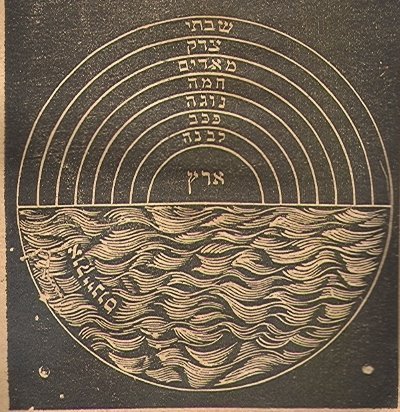

sacred geometry: circles in Jewish folklore & mysticism
we’ve finally made it to unit four in YIVO’s Folklore of Ashkenaz class, which deals directly with folkloric ritual & belief - this is what i signed up for! in the first lecture, Professor Gottesman discussed the importance of circles - believed to be perfect shapes with the power to ward off evil - throughout many different Jewish customs. some examples:
circling one’s body to keep away demons
circling the groom under the wedding canopy for luck/protection
circling while beating willow branches on Hoshana Rabbah
eating bagels after returning from a burial to evoke the cycle of life and death, including common Diasporic Jewish belief in reincarnation
circling graves of pious Jews with thread, which is later used as wicks for candles in the synagogue (read more about kosher fodem here)
a folk remedy for eye swelling includes circling the eye with a ring
another folk remedy to prevent the further growth of hunchback calls for circling the hump with the hand of a dead man (!)
circles are a common motif on Jewish amulets, and ilan sefirot (diagrams of the Kabbalistic tree of life) often represent each sefira as a circle. feel free to reblog with more examples of Jewish circles! (kippahs/yarmulkes come to mind)
the top image is from a copy of the Sefer Raziel HaMalach published in Vilna in 1875, and while i couldn’t find a source on the bottom image, it appears to be a medieval volvelle with Hebrew lettering - would love to know more!
1K notes
·
View notes
Photo
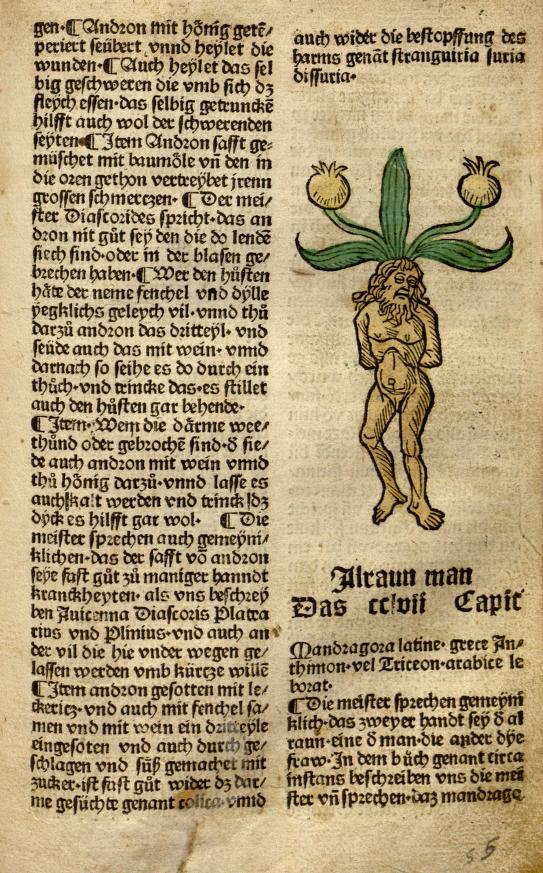

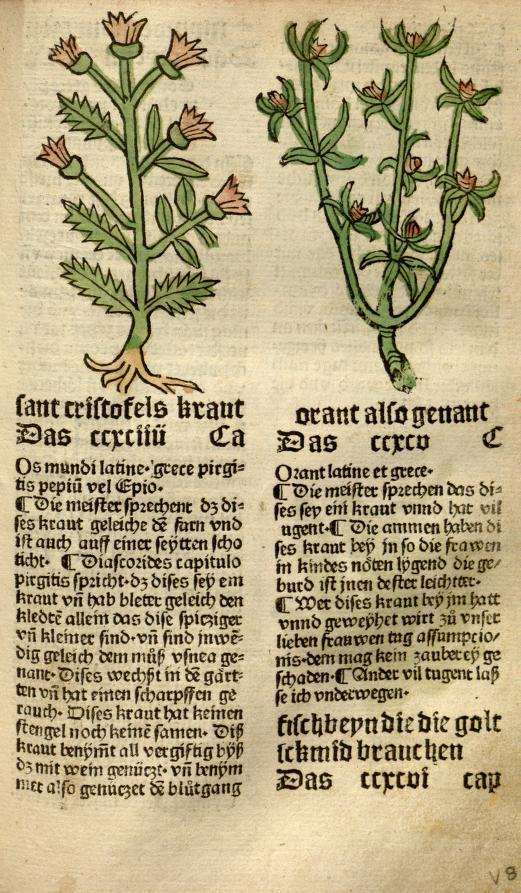

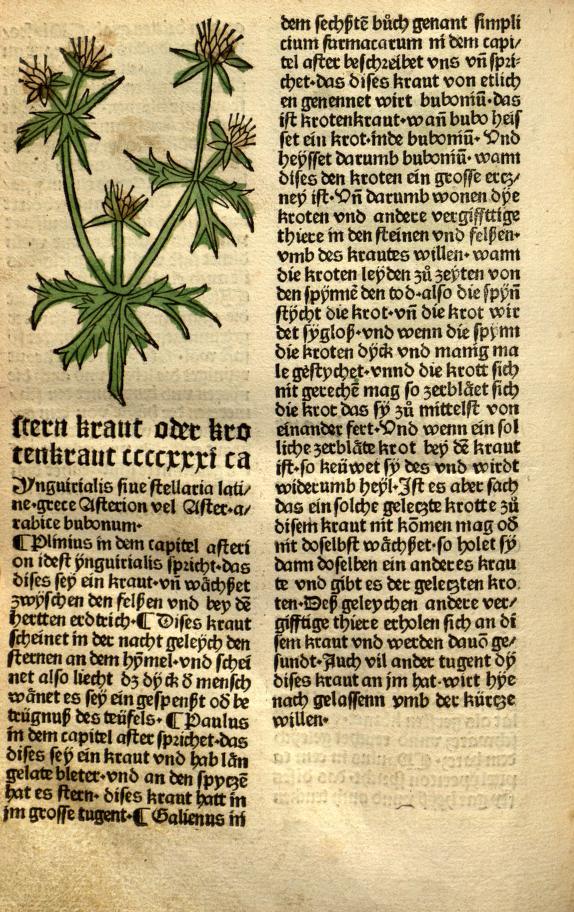

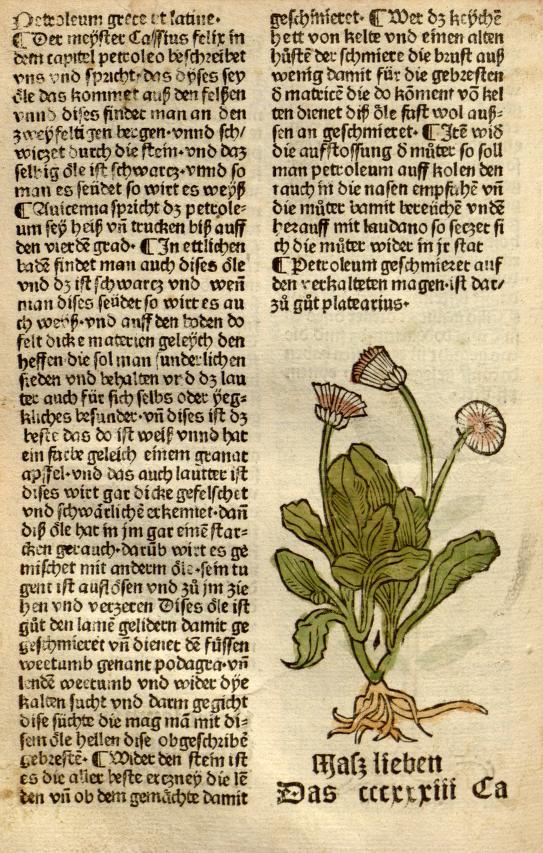
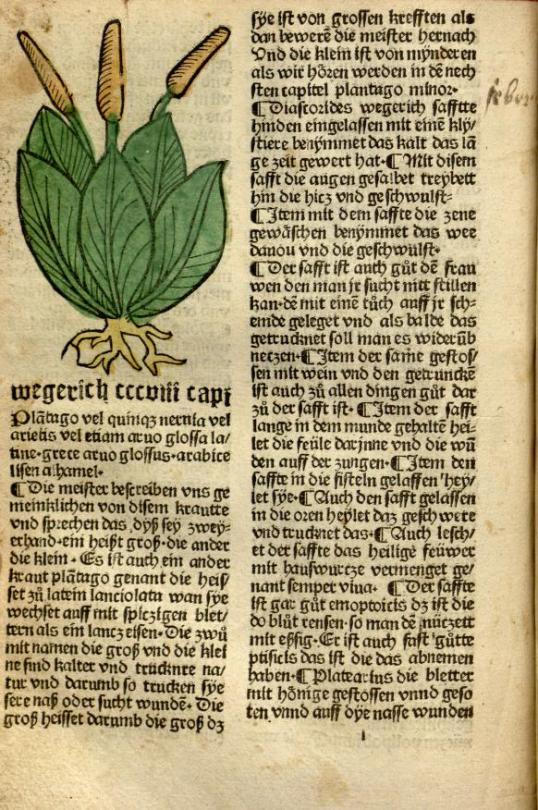
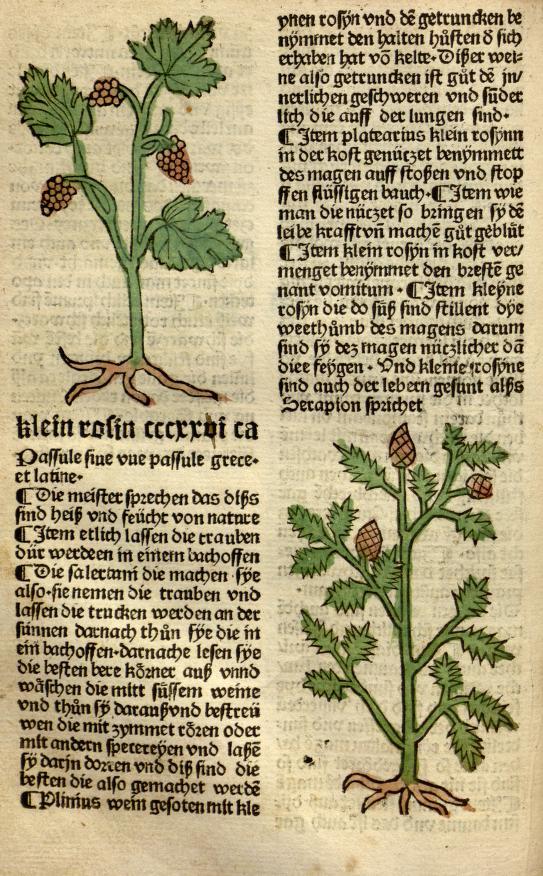
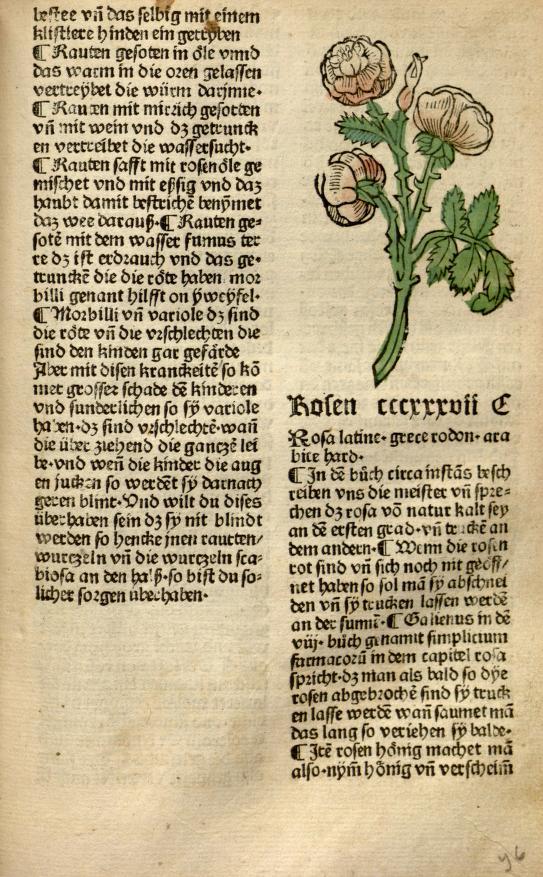
Botanical illustrations taken from ‘Gart der Gesundheit’ by Hamsen Schonsperger. Published 1487.
Missouri Botanical Garden. http://www.biodiversitylibrary.org/permissions
archive.org
329 notes
·
View notes
Text
The Binding of St. Anthony
traditional Italian love binding, English version © Trollkatt
This ritual is to be performed on a Friday, on a crescente - i.e. waxing* - moon, in the hour of Venus. It is performed to bind a beloved person to you, or to make a beloved person return to you.
Take two white candles and lay them down, one to the right and the other to the left on the table, and then place a small picture or statue of St. Anthony between them. Take a lemon, and place it before the image of the saint. Then light liturgical incense and invoke him:
I invoke you, oh, lily immaculate, blessed St. Anthony, I repent my sin and ask your help. Blessed St. Anthony, for the love of the god child who is by your side, I ask you to grace me with … [ask for what you want]
Baptize the lemon, sprinkling it with holy water (taken in a male church) and with salt, saying:
Lemon creature, I baptize you with the names of … [names, surnames and birth dates of the two people to tie] in the name of the Father + the Son + and Holy Spirit + Amen.
The three + mean you shall make the sign of the cross over the lemon three times.
Then with a new and never used knife, cut the lemon into two, insert personal concerns of yourself and the person you are binding to you, or your photos, together with the image of the saint.
Take a piece of red yarn 13 inches long on which you make nine knots, for each knot saying:
Oh, great saint of miracles, most beloved St. Anthony, before your name death, horrors, disgace, lepra, and evil spirits all flee; before your name, oceans and chains break; make it so that … [the personal details of the person you are binding] can’t go against my will without feeling your heavy hand under which oceans and chains break. Amen.
Recite a credo, and finish the operation of the nine knots by tying the thread around the lemon to close it and say:
St. Anthony of miracles, bind him/her hard … [make the knot] so that s/he never will forget … [your name]
Then take the lemon and bury it in an open field or under a big tree, or even better, hide it in the house of the person you are binding, while saying:
St. Anthony, my beautiful, protect our love, I ask by your holy intercession, that … [details of person to bind] is bound to me like the god child who is by your side. Amen.
The next morning bring the two white candles to the church where you burn them and make a prayer to the saint.
Notes
* In Italian, the word crescente means “growing” as in “in the state of growing”. It has the same origin as the English “crescent”, namely the Latin verb crescere “to grow”, which exists also in modern Italian. To say “waning moon”, you use the phrase luna calante.
278 notes
·
View notes
Text
To scry in liquor
as told to folklorist Levi Johansson, possibly in 1915 by blacksmith Jonas Kihlberg in Hammerdal (in today’s Strömsund municipality, Jämtland, Sweden), who was taught trolldom by an unnamed elderly Finnish woman (from the archives of Länsmuseet Västernorrland, booklet VI-1917, note no. 1475)
You buy a little bit of church soil for a silver coin from the spirit guardian at the graveyard. Then you take nine grains of this soil, nine grains of gunpowder and nine grains of sulphur and put them in a glass of liquor, after which you say: “I now demand to see the person, who is suspected of something, and I now let go the rede of the name of God and I demand help from the devil to see his or her face.” Then you get to see in the liquor the image of the person who has done such or such, that you want to have revealed. This is to be done a Thursday night after sunset.
What the informant omits (because to him - and to everybody else of his era - it is so obvious he doesn’t even think of it) is that the “church soil” is to be taken from the northern corner of the graveyard or from the north side of the church itself, but not from a grave. When you take soil from a grave, you buy (or lease) it from the occupant of that grave, not from the graveyard spirit guardian.
It is common practice to say something like “It is not stealing, because I am leaving [such and such] in its place,” when you buy stuff from the dead or from spirit guardians of a place. When you lease something, you say something like, “It is not stealing, because I leave [such and such] as a pledge until I have returned that which I am borrowing.”
When you leave the graveyard, you walk backwards until you are outside the gate, where you turn around, and hurry homewards (preferably by a different route than that by which you arrived) without looking back. Ritual silence must be observed from the moment you leave your home until sunrise the next morning.
If you are scrying for someone else, they must bring the bottle of liquor - new and unopened, and what is not used in the ritual (and ritually disposed of afterwards) is yours to keep as payment. This is but one way to scry in liquor, there are many others.
599 notes
·
View notes
Text
Love Divinations for Hallowe'en – from Nummits and Crummits by Sarah Hewett

"I THINK I cannot do better than describe what actually took place at an old farm house, in the eighties, in South Devon. I was invited to spend a few days with a family, consisting of a farmer, his wife, and seven grown-up sons and daughters. The farm was picturesquely situated on a south-western slope of the Haldon Hills, from whence extensive views of land and sea could be enjoyed. Mary was the youngest and merriest of the family. She it was who acted as prime mover in all the fun, not that either of the others showed any reluctance to carry out her wildest suggestions. A brighter set of young folk it would be difficult to find, and it has sel- dom been my good fortune to meet their equals in high spirits and natural gentleness. Every one was thoroughly imbued with credulity in regard to omens and predictions. Mary suggested that All Hallowe'en should be ob- served with due ceremony, as indeed it was. The amusements began with fortune-telling by cards, at which Maggie the eldest daughter was an adept. The fortunes were appraised as "not up to much," and as no one crossed Maggie's hand with a piece of silver, the cards were swept aside. Then Jack, otherwise the family clown, brought in dishes of apples and nuts, bags of hemp seed, torn paper, large basins of water, scraps of lead, a melting ladle, large combs, small hand mirrors, and a printed sheet of capital letters, all of which were to be used as love-charms. Just as the clock began to strike eleven, a move was made towards the fireplace, where from the bars of the grate Jack had already swept every vestige of ashes. Simultaneously each girl laid a big hazel nut on the lowest bar of the grate, and sat silently watching the result. I noticed that perfect silence was religi- ously observed during each ceremony. She, whose nut first blazed, would be the first to marry. She, whose nut first cracked, would be jilted. She, whose nut first jumped, would very soon start on a journey, but would never marry. She, whose nut smouldered, would have sickness, disappointment in love, and perhaps die young. After this, one of the girls took an apple, a comb, and a mirror, and retired to the brightest corner of the room, where she began to comb out her long tresses with her left hand and held an apple in the right, which she slowly ate. Her future husband was expected to look over her shoulder, revealing his face to her in the mirror. He did not, however, satisfy our curiosity by putting in an appearance. Then one took a handful of torn paper and scattered it on the surface of a big basin of water, and after stirring vigorously, awaited developments. The number of pieces of paper which fell to the bottom indicated the number of years which would intervene before the operator's marriage. In this case twenty- one fell, and as Jenny was now twenty-eight, Jack thought there was small chance for her to have an establishment of her own at forty-nine, so she had better resign herself to her fate, and be content to be- come the unappropriated blessing of the family, for, said he, " How could you, Jenny, at that advanced age, dare to don white satin and orange blossoms ? No, my dear, your future is sealed." Then everybody insisted on Jack trying his luck, which he essayed to do by melting a few scraps of lead in the ladle and pouring it red hot into one of the basins of cold water. The letters formed, or the nearest approach to letters, at the bottom of the basin were supposed to be the initials of the future " She." The closest resemblance to letters which we could discover was an I, and an L. The question which now arose amid merry peals of laughter was to whom the initials I.L. could belong. Many names were mentioned and negatived as soon as suggested, Jack looking rather bashful, when from Jenny came the query " Does not I stand for Ida, and L for Lang ? Ida Lang is a very pretty name, and is owned by a very sweet girl." Jack gave Jenny a look which could easily be in- terpreted " I owe you one for that, Jenny " " Oh ! oh ! Jack," replied Jenny, " we are hoping that Ida Lang will not be an unappropriated blessing. She shall have my white satin and all the orange blossoms." There was a good deal more of this sort of chaff, but no offence was taken by the good-natured Jack, and things swung along amicably. Next came Tom to try his hap with a pair of scissors. Tom in silence separated the capital letters, each falling into the basin of water without being touched by the hand. When all were free they were stirred and left to settle. The initials of the future one, were supposed to float on the water. Alas ! poor Tom ! in his case fifteen letters presented themselves. Here again was food for fun and conjecture. Many suggestions were made. Tom, perhaps was going to be a Mormon, or perhaps he was going abroad and set up a harem, and all sorts of other absurd theories. Mary at last came to the rescue, " Oh, I know," said she, " take G and M out and there you have Gertrude Morley, then tack all the rest on to the end of the name, and there you have certain degrees won by Gertrude at the 'Varsity. Gertrude is a Newnham student. Last autumn in the long vacation there was a young woman of that strain dodging across the hills, and on one occasion when she saw our Tom cantering towards her, her bike became fractious instanter, and poor innocent Tom had to dismount, tie Highflyer to a gate-post and assist the distressed biker. Of course, Tom couldn't help himself and had to lead Highflyer up the hill and push the bike too." Alas poor Tom ! Then turning to her mother she explained that Tom was about to present her with a new daughter in the form of a Newnham girl so vastly clever, that she used up all the alphabet to shew how clever she was and the heaps of degrees she took, &c., &c. " I say, Tom, do you think Gertrude Morley, B.A., M.D., M.G.L.Q.R., will like taking my place in the house work, and be able to cry chuggie, chuggie, chuggie, every morning to the dear little piggy-wiggies ; perhaps though, instead of giving them barley-meal and milk, she'll sit them all in a row, in the bottom of the trough, and teach 'em Latin and Greek don't-cher-know ; eh, Tom dear ? " Heedless of this affectionate raillery, everything drifted along smoothly, and four dishes of water were brought in and placed severally in three corners of the room, and the fourth, emptied of its contents, was placed in the fourth corner. Then four blind-folded operators were led into the room and placed back to back in its centre, the lights having been previously extinguished. Then all four fell on their knees and each crept at discretion to any, or all to the same, corner. The empty dish portended celibacy or poverty. The dish of clean water, that the future one would never before have married. The dish of dirty water, that the future spouse would be a widow or widower. The dish of water with pebbles at the bottom, riches and honour. Now the crucial movement was at hand. Each girl took possession of a big handful of hempseed. The front door was thrown wide open and securely fastened back to prevent the possibility of its being accidentally closed ; the girls stood without. As the clock gave the first stroke of twelve off they started each in a different direction across the lawn, shouting : Hempseed I sow, Hempseed I throw, He that's my true-love, Come after me and mow ! The spirits of the future ones were expected to be beyond the shrubs ready to rush after the sowers, and unhappy would have been the maiden, who could not get over the threshold before the scythe of the reaper caught her. All the girls reached the hall un- harmed : little Mary, looking a bit scared, said, as she wound her arms around me : " Oh, wasn't I just about startled ? indeed, I was, for I thought I saw Dick Harvey right in front of me as I turned to come back, holding a bright new sickle over his head." I felt the child tremble, and then I enquired, " Who is Dick Harvey ? " " Oh, nobody in particular, don't tell." Of course I have not told till now. After supper we retired for the night. The next morning the girls told me, that sometimes they placed tiny scraps of bridecake, wrapped in tissue paper, under their pillows at night, hoping they would dream of " him : " at other times made a " dumb cake," and gave me a recipe for making one, which I append. Jenny told me too, that one evening when visiting friends at Paignton, one of the party saw for the first time the new moon : she called all the young folk out on the balcony requesting each to bring a small hand- mirror, to turn their back to the moon, and holding up the mirrors to catch the reflection of the moon. As many reflections as were cast on the glass, so many years would pass before the marriage of the holder took place. One charming girl of the party told me : "I had three moons. Fancy that, my dear, and you know how very old I am now, and have three years of weary waiting yet." That delightful family is broken up. The parents are both dead, and the children are scattered to the ends of the earth. Not one is left in England. Each member has carried the old songs, the old dialect, and the old folk-lore of the old country, into new homes, in new countries, and there in time a new generation will spring up, who will be taught the traditions of the past ; and perhaps the incidents of that happy All Hallowe'en, spent amidst the uplands of dear old Devon, will form one of the pleasantest narrations. Poor Dick Harvey never came to claim little Mary, for, very soon after that happy evening, news came of a great storm, and Dick, who was first officer of the ss. Petrel, was lost with all hands in mid Atlantic. Everywhere throughout the length and breadth of Great Britain, the festive and fortune-telling practices of this evening are observed in almost identical fash- ion. Gray, in The Spell, tells us that Two hazel-nuts I threw into the fire, And to each nut I gave a sweetheart's name. This, with the loudest bounce, me sore amazed, That, in a flame of brightest colour blazed : As blazed the nut so may thy passion grow, For 'twas thy nut that did so brightly glow." Then we have in Niit burning on All Halloweve, by Charles Graydon, the following These glowing nuts are emblems true, Of what in human life we view ; The ill-matched couple fret and fume, And thus in strife themselves consume ; Or from each other wildly start, And with a noise for ever part. But see the happy, happy pair, Of genuine love and truth sincere With mutual fondness while they burn, Still to each other kindly turn ; And as the vital sparks decay, Together gently sink away : Till life's fierce ordeal being past, Their mingled ashes rest at last. Burns, too, contributes a long poem on " Hal- loween," which gives us an insight into the manners and traditions of the peasantry in the West of Scot- land in his time. The old goodwife's well hoarded nuts Are round and round divided : And many lads' and lasses' fates Are there that night decided : Some kindle, couthie, side by side And burn together trimly ; Some start away with saucy pride And jump out o'er the chimney Full high that night."
– From Nummits and Crummits: Devonshire Customs, Characteristics, and Folk-lore
by Sarah Hewett
42 notes
·
View notes
Text
History of Samhain (Oct. 31st–Nov. 1st)
“The four great points of the ancient Irish year are neatly set out in the Ulster tale of the wooing of Emer by Cu Chulainn. Among various tasks which she set him before he could wed her, was to go sleepless from ‘Samhain, when the summer goes to its rest, until Imbolc, when the ewes are milked at spring’s beginning’…In the Yellow Book of Lecan, a high medieval text preserving some early medieval tales, it is said that the common people called Samhain ‘the feast of Mongfind’ instead. Legend made Mongfind a witch-queen married to an early king of Tara, but fact that the same source states that the people still prayed to her on 31 October indicates that we are dealing here with another goddess: queens and heroines were not prayed to, or given commemorative feasts…

“Of the four festivals, there is no doubt whatsoever from the literature that Samhain, which began the year in November, was the most important. Tribal assemblies were held then, rulers and warriors conferred and laws were made. It was also the time at which humans were most susceptible to divine and supernatural interference. At Samhain heroic and royal figures met fated deaths or enchantments. Spirits, monsters or fairies attacked royal capitals, with physical destruction or with evil spells. Divine women allowed themselves to be wooed by human males. Supernatural beings fought or mated with each other, while warriors, gathered in royal halls, made important boasts or challenges. Magical gifts were presented to kings, or things stolen magically from them. It is worth stressing that most of these occurrences took place in daylight, so the whole day of 1 November was regarded as exciting and perilous, and not just (as in modern times) the night before…
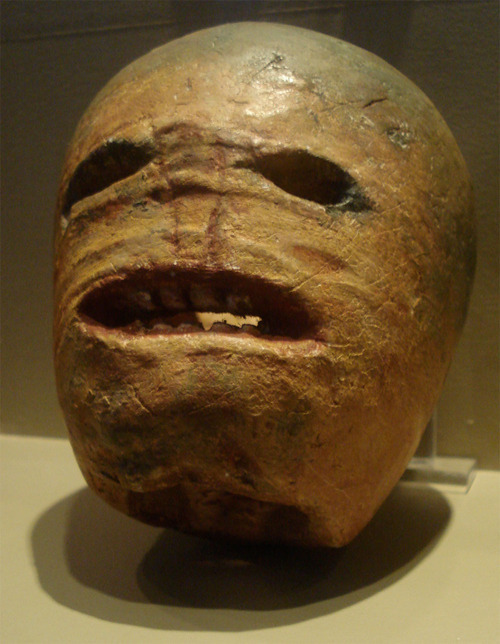
"There is the case of Hinton St George, a Somerset village through which, upon the last Thursday evening of October, the children carry hollowed-out mangel-wurzels containing candles. The shells of the vegetables are carved with faces or designs, some of great beauty. They are called 'punkies,’ and the event bears the name 'Punky Night’. The popular books upon English folklore and calendar customs published during the 1960s tended to describe thias a vestige of honouring of vegetation spirits at Samhain. At Hinton, as at Killorglin, I was given two explanations by the villagers for what they were doing. One lady told me that the word punkie came from 'spunkie’, and the word used in mid-Somerset for the little flames of ignited marsh gas known elsewhere as will-o’-the-wisps or jack-o’-lanterns. She went on to say that they were believed to be the souls of dead babies, and that the Hinton tradition was designed originally to honour and to placate them at the season of Samhain. Others among the villagers were quite irritated by her ideas. They agreed upon the origin of the name, but insisted that the punkies were first carved as genuine lanterns, to guide the men of Hinton back from a fair held in late October at a nearby village. Their families would turn out to welcome them home, and the procession and merrymaking became a festivity in its own right which endured after the feast ceased to be held. Nobody in Hinton that night had much time for the idea of vegetation spirits…
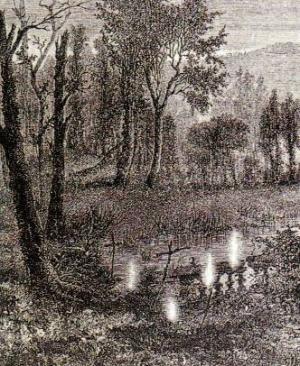
"There is ample evidence of the importance of Samhain in all the modern Celtic regions, namely Ireland, Man, the Highlands and Western Isles, Wales and Cornwall, though the focus has been shifted back on to the previous night, called in English Hallowe'en. The rites and festivities concerned revolve around feasting, bonfires and divination. By contrast, there were no comparable celebrations associated with that date in most of England and some of Scotland until modern America helped to transmit the Irish festival to Britain. So it really does appear to have been a feast known all over the Iron Age British Isles, with no equivalent among the Anglo-Saxon invaders…
"Nearly 4,000 years were to pass…Over the same period, several major ancient festivals were Christianized by being awarded to particular patrons: thus, Samhain’s importance was recognized by its transformation into All Saint’s Day…
"One of the most blatant translations of an offering to a pagan deity persisted on the Isle of Lewis in the Outer Hebrides until the mid-seventeenth century. At Hallowe'en fishermen would go down to the shore, kneel at the edge of the waves and repeat the Christian Paternoster. One of them waded in up to his waist, poured out a bowl of ale and asked a mysterious being called Shoney (Johnny) for a good catch over the next year. Then they went to St Malvey’s chapel and sat in silence for a while before making merry in the fields for the rest of the night.”
– The Pagan Religions of the Ancient British Isles by Ronald Hutton

2K notes
·
View notes
Text
“There are different magical remedies involving apple trees and apples. A New England remedy from 1879 for curing ague, recommends that a person take a piece of yarn made from three colors and go alone to an apple tree. The person should then tie the yarn loosely to the tree and their left hand, and while using their right hand, quickly slip their hand out of the yarn and run away without looking back, this being an example of transference magic. Another transference charm for curing warts from Devonshire was to cut an apple into two pieces, rub half on the wart and give it to a pig to eat, eating the other half yourself. A simple charm for rheumatism was to carry half an apple in your pocket. An interesting remedy comes from Irish wise women and faerie doctors - the roots of an apple tree that bears red apples and the roots of an elder tree, together boiled in water if drunk fasting had the power to expel any spirit that has possessed a person’s body or soul.”
— Corinne Boyer - Under the Witching Tree, pgs. 64-65 (via blackthornwren)
403 notes
·
View notes